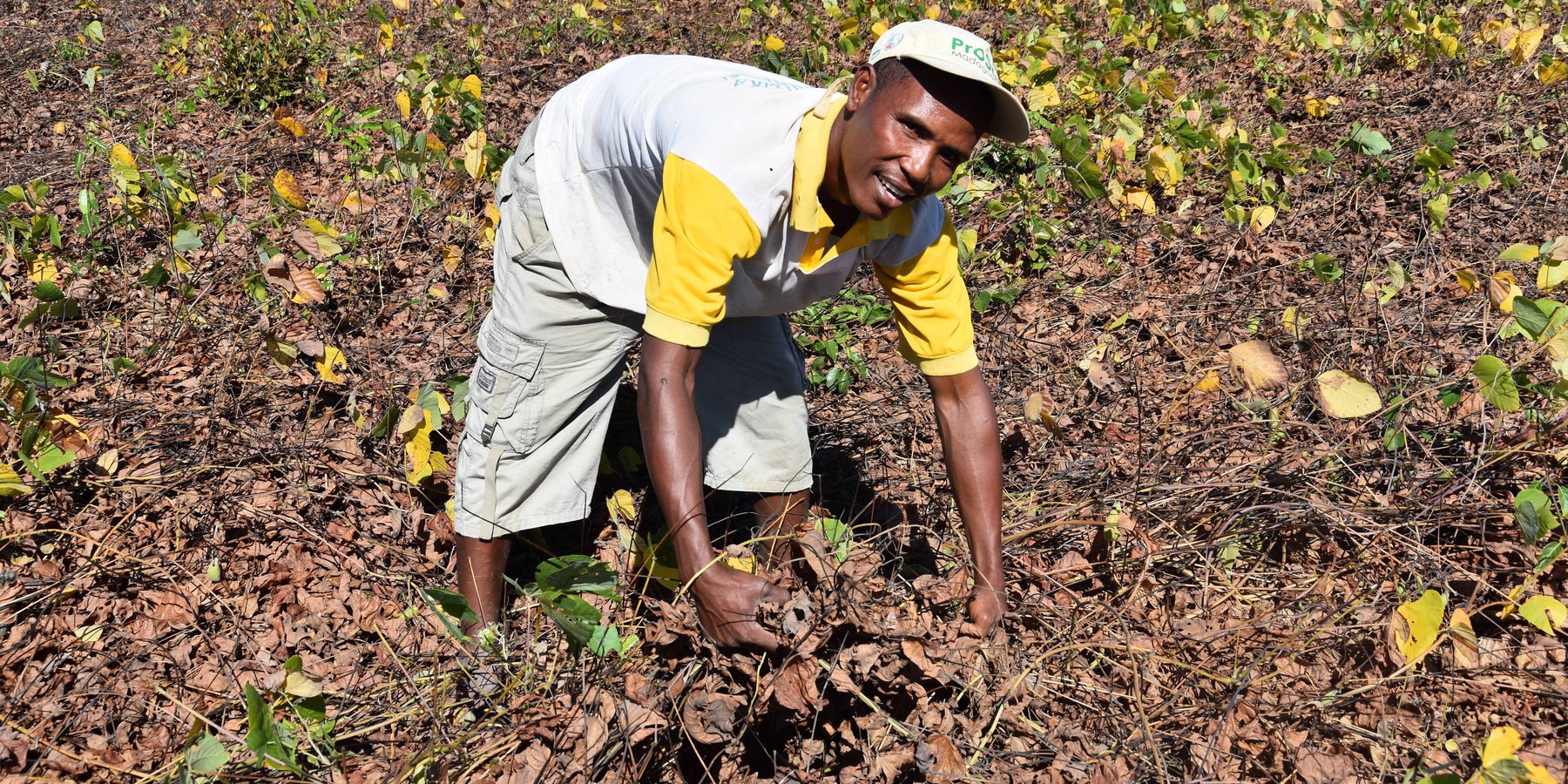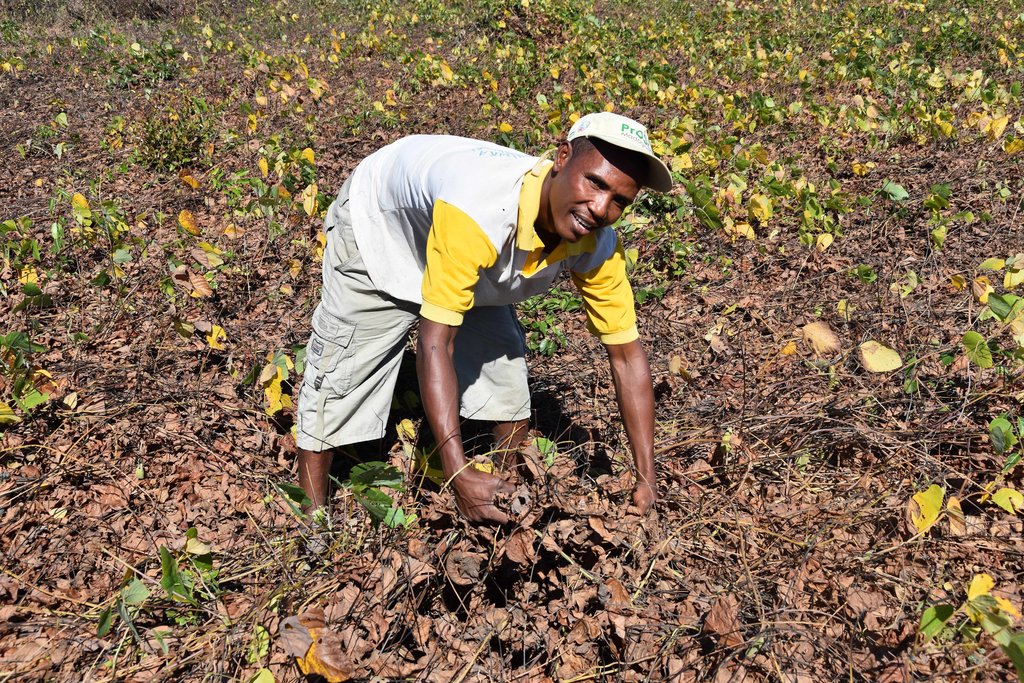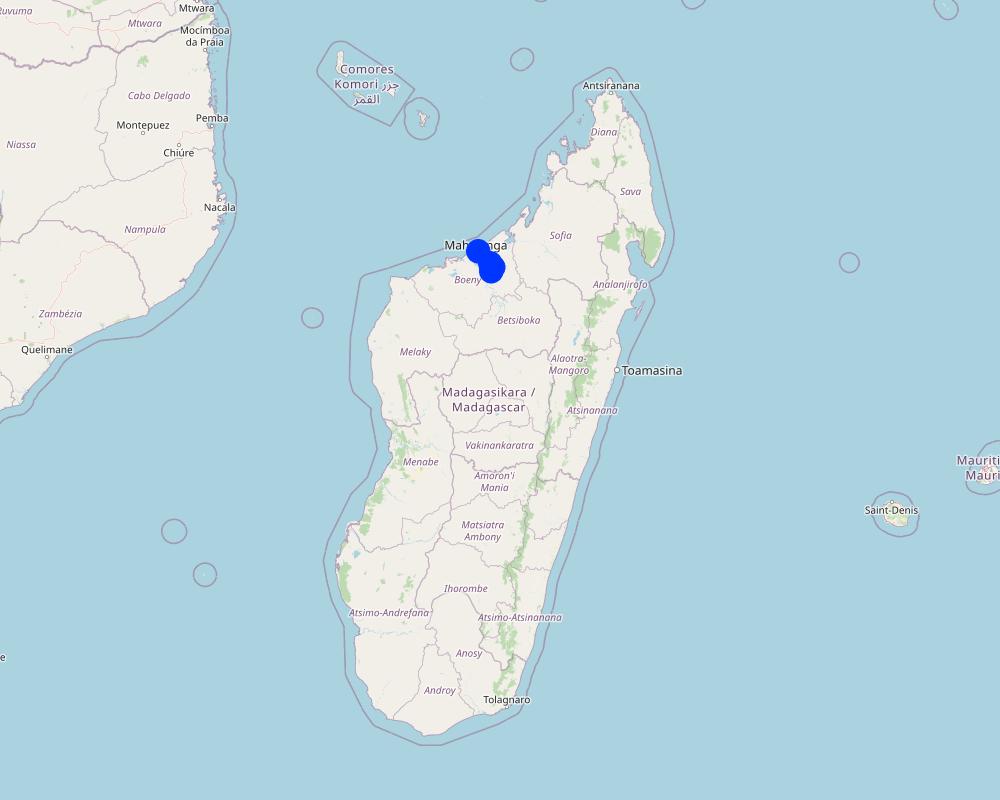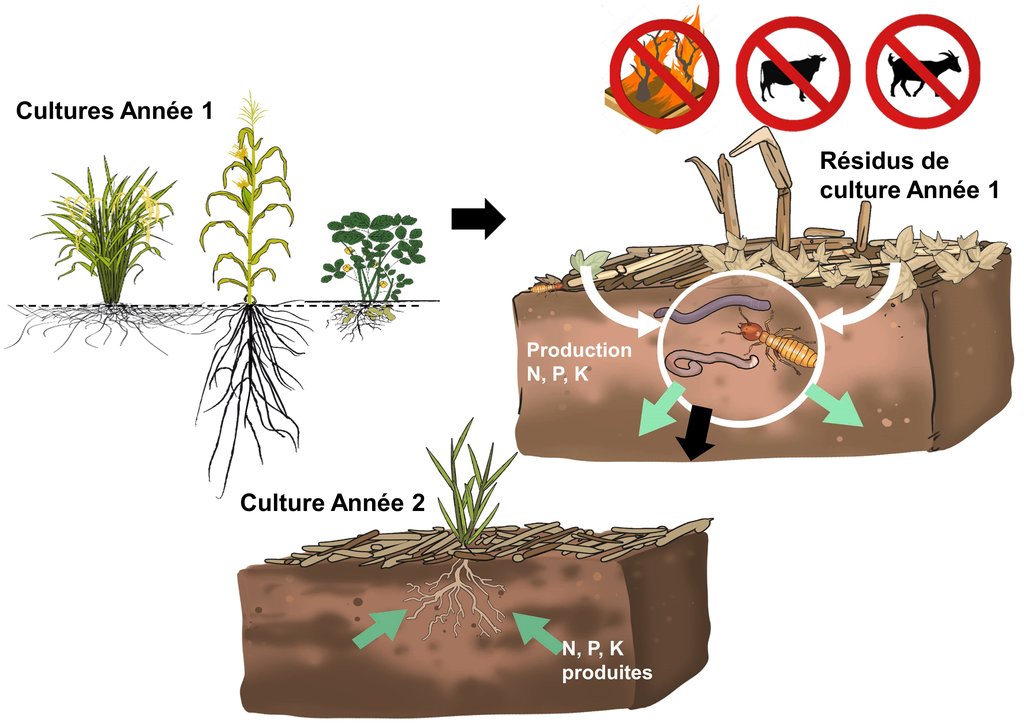Crop Residue Management [Madagascar]
- Creation:
- Update:
- Compiler: Harifidy RAKOTO RATSIMBA
- Editors: Felana Nantenaina RAMALASON, Dimby RAHERINJATOVOARISON, Siagbé Golli, Tahiry Ravivonandrasana, Natacha Rabeary, Tabitha Nekesa, Ahmadou Gaye
- Reviewers: William Critchley, Rima Mekdaschi Studer
Fitantanana sisam-boly, Fitantanana sisam-bokatra, Rakotra maty avy amin'ny sisam-boly
technologies_6472 - Madagascar
View sections
Expand all Collapse all1. General information
1.2 Contact details of resource persons and institutions involved in the assessment and documentation of the Technology
Key resource person(s)
land user:
RAFARAMALALA Denise Germaine
Madagascar
land user:
DAMY
Madagascar
land user:
RATOVONIRINA Alison Johnny
Madagascar
land user:
DOMA JEAN Landry
Madagascar
land user:
RABOTOZAFIARIMBOLA Samuelson
Madagascar
Name of project which facilitated the documentation/ evaluation of the Technology (if relevant)
Soil protection and rehabilitation for food security (ProSo(i)l)Name of the institution(s) which facilitated the documentation/ evaluation of the Technology (if relevant)
Deutsche Gesellschaft für Internationale Zusammenarbeit (GIZ)1.3 Conditions regarding the use of data documented through WOCAT
The compiler and key resource person(s) accept the conditions regarding the use of data documented through WOCAT:
Yes
1.4 Declaration on sustainability of the described Technology
Is the Technology described here problematic with regard to land degradation, so that it cannot be declared a sustainable land management technology?
No
2. Description of the SLM Technology
2.1 Short description of the Technology
Definition of the Technology:
Crop residue management consists of leaving crop residues on farmland after harvest. This reduces evaporation during the dry season. The decomposition of the residues contributes to improved soil fertility, while the underground biomass (roots) enhances soil structure. In the case of legumes, root nodules provide nitrogen for subsequent crops.
2.2 Detailed description of the Technology
Description:
Crop residue management involves leaving crop residues on farmland after harvesting, and is practiced on all types of cultivated land, whether on plains, slopes ("tanety") or in alluvial zones ("baiboho"). On steep slopes, where cassava plots are intercropped with stylosanthes or brachiaria, no-till cultivation with crop residues prevents erosion during rainy periods.
This technology protects the soil against erosion and maintains soil fertility, which improves annual yields. The plant cover left on the plots facilitates infiltration of rainfall and reduces evapotranspiration. It can also reduce weed growth, and improve porosity while encouraging the development of living soil organisms. In the case of leguminous crops, the decomposition of their roots and nodules releases nitrogen that can benefit subsequent crops. Crop residues can be used as seedbed litter for no-till crops, or as green manure through ploughing when plant remains are buried.
Weeding before seeds are produced is essential for no-till sowing or burying crop residues, especially in rich soils (baiboho). Failure to weed in a timely manner may compel farmers to burn residues to prevent weeds from proliferating in the next crop.
Crop residues also compete with livestock feed, as leguminous residues can be sold, especially during the rainy season. Cattle grazing on crop residues is widespread, and residue owners are forced to accept this to avoid conflicts with their neighbours. Additionally, plot owners themselves may feed their own cattle with the residues during the dry season. This is why this technique requires good management of forage resources, for example through fodder production.
2.3 Photos of the Technology
2.5 Country/ region/ locations where the Technology has been applied and which are covered by this assessment
Country:
Madagascar
Region/ State/ Province:
Boeny
Further specification of location:
Ambalakida, Belobaka, Antanambao Andranolava, Marovoay Banlieue
Specify the spread of the Technology:
- evenly spread over an area
If precise area is not known, indicate approximate area covered:
- < 0.1 km2 (10 ha)
Is/are the technology site(s) located in a permanently protected area?
No
Map
×2.6 Date of implementation
Indicate year of implementation:
2020
If precise year is not known, indicate approximate date:
- less than 10 years ago (recently)
2.7 Introduction of the Technology
Specify how the Technology was introduced:
- through projects/ external interventions
Comments (type of project, etc.):
GIZ ProSoil Madagascar
3. Classification of the SLM Technology
3.1 Main purpose(s) of the Technology
- improve production
- reduce, prevent, restore land degradation
- adapt to climate change/ extremes and its impacts
3.2 Current land use type(s) where the Technology is applied
Land use mixed within the same land unit:
No

Cropland
- Annual cropping
Annual cropping - Specify crops:
- cereals - maize
- cereals - rice (upland)
- cereals - sorghum
- legumes and pulses - beans
- legumes and pulses - other
- vegetables - melon, pumpkin, squash or gourd
- Vigna radiata, cowpea
Number of growing seasons per year:
- 1
Is intercropping practiced?
Yes
If yes, specify which crops are intercropped:
Maize + Vigna Radiata/ Maize + Cowpea/ Sorghum + Cowpea, Maize + Sorghum
Is crop rotation practiced?
Yes
3.3 Has land use changed due to the implementation of the Technology?
Has land use changed due to the implementation of the Technology?
- No (Continue with question 3.4)
3.4 Water supply
Water supply for the land on which the Technology is applied:
- rainfed
3.5 SLM group to which the Technology belongs
- improved ground/ vegetation cover
- integrated soil fertility management
3.6 SLM measures comprising the Technology

agronomic measures
- A1: Vegetation/ soil cover
- A2: Organic matter/ soil fertility
- A3: Soil surface treatment
3.7 Main types of land degradation addressed by the Technology

soil erosion by water
- Wt: loss of topsoil/ surface erosion
3.8 Prevention, reduction, or restoration of land degradation
Specify the goal of the Technology with regard to land degradation:
- prevent land degradation
- reduce land degradation
4. Technical specifications, implementation activities, inputs, and costs
4.1 Technical drawing of the Technology
Technical specifications (related to technical drawing):
Crop residues should be left on the plot away from animals, without being burnt. They can be cut into pieces to facilitate decomposition. Crop residues will provide nutrients for future crops.
Maintaining crop residues requires the enforcement of a number of measures to prevent livestock herds from straying, including fencing and agreements with livestock farmers to prevent their animals from entering the plots.
Author:
GIZ ProSoil Madagascar
Date:
01/02/2023
4.2 General information regarding the calculation of inputs and costs
Specify how costs and inputs were calculated:
- per Technology area
Indicate size and area unit:
1 hectare
other/ national currency (specify):
Ariary
If relevant, indicate exchange rate from USD to local currency (e.g. 1 USD = 79.9 Brazilian Real): 1 USD =:
4300.0
Indicate average wage cost of hired labour per day:
5000
4.4 Costs and inputs needed for establishment
| Specify input | Unit | Quantity | Costs per Unit | Total costs per input | % of costs borne by land users | |
|---|---|---|---|---|---|---|
| Equipment | Machete | number |
Comments:
Crop residue management does not really generate any setup costs. The listed costs are more associated with cleaning the plot during soil preparation and cutting crop residues. While the latter is optional, most farmers interviewed practice it to accelerate the decomposition of crop residues.
4.5 Maintenance/ recurrent activities
| Activity | Timing/ frequency | |
|---|---|---|
| 1. | Soil preparation (cleaning, weeding) | November-January |
| 2. | Cutting crop residues | March-June |
| 3. | Protection against cattle grazing | July-November |
Comments:
The farmers surveyed preferred to protect their plots from livestock roaming in their cultivation zone, to prevent the crop residues from being completely grazed out by animals, leaving nothing left to nourish the soil.
4.6 Costs and inputs needed for maintenance/ recurrent activities (per year)
| Specify input | Unit | Quantity | Costs per Unit | Total costs per input | % of costs borne by land users | |
|---|---|---|---|---|---|---|
| Labour | Protection against grazing | man-days | 7.0 | 10000.0 | 70000.0 | 100.0 |
| Labour | Cutting crop residues (optional) | man-days | 20.0 | 5000.0 | 100000.0 | 100.0 |
| Labour | Protection against cattle grazing | man-days | 3.0 | 10000.0 | 30000.0 | 100.0 |
| Equipment | Machete | number | 4.0 | 20000.0 | 80000.0 | 100.0 |
| Total costs for maintenance of the Technology | 280000.0 | |||||
| Total costs for maintenance of the Technology in USD | 65.12 | |||||
5. Natural and human environment
5.1 Climate
Annual rainfall
- < 250 mm
- 251-500 mm
- 501-750 mm
- 751-1,000 mm
- 1,001-1,500 mm
- 1,501-2,000 mm
- 2,001-3,000 mm
- 3,001-4,000 mm
- > 4,000 mm
Specify average annual rainfall (if known), in mm:
1400.00
Agro-climatic zone
- sub-humid
5.2 Topography
Slopes on average:
- flat (0-2%)
- gentle (3-5%)
- moderate (6-10%)
- rolling (11-15%)
- hilly (16-30%)
- steep (31-60%)
- very steep (>60%)
Landforms:
- plateau/plains
- ridges
- mountain slopes
- hill slopes
- footslopes
- valley floors
Altitudinal zone:
- 0-100 m a.s.l.
- 101-500 m a.s.l.
- 501-1,000 m a.s.l.
- 1,001-1,500 m a.s.l.
- 1,501-2,000 m a.s.l.
- 2,001-2,500 m a.s.l.
- 2,501-3,000 m a.s.l.
- 3,001-4,000 m a.s.l.
- > 4,000 m a.s.l.
Indicate if the Technology is specifically applied in:
- not relevant
5.3 Soils
Soil depth on average:
- very shallow (0-20 cm)
- shallow (21-50 cm)
- moderately deep (51-80 cm)
- deep (81-120 cm)
- very deep (> 120 cm)
Soil texture (topsoil):
- coarse/ light (sandy)
- medium (loamy, silty)
Soil texture (> 20 cm below surface):
- medium (loamy, silty)
- fine/ heavy (clay)
Topsoil organic matter:
- low (<1%)
5.4 Water availability and quality
Ground water table:
5-50 m
Availability of surface water:
medium
Water quality (untreated):
poor drinking water (treatment required)
Water quality refers to:
ground water
Is water salinity a problem?
No
Is flooding of the area occurring?
No
5.5 Biodiversity
Species diversity:
- high
Habitat diversity:
- low
Comments and further specifications on biodiversity:
The region is home to a diverse array of flora and fauna species, including some that are native. The management of harvest residues contributes to the improved development of soil fauna. However, in terms of habitats, only around 20% of the area can serve as a habitat for this biodiversity (forests, bodies of water, mangroves, etc.), which remains fairly low.
5.6 Characteristics of land users applying the Technology
Sedentary or nomadic:
- Sedentary
Market orientation of production system:
- subsistence (self-supply)
- mixed (subsistence/ commercial)
Off-farm income:
- less than 10% of all income
- 10-50% of all income
Relative level of wealth:
- poor
- average
Individuals or groups:
- individual/ household
- groups/ community
Level of mechanization:
- manual work
- animal traction
Gender:
- women
- men
Age of land users:
- youth
- middle-aged
- elderly
5.7 Average area of land used by land users applying the Technology
- < 0.5 ha
- 0.5-1 ha
- 1-2 ha
- 2-5 ha
- 5-15 ha
- 15-50 ha
- 50-100 ha
- 100-500 ha
- 500-1,000 ha
- 1,000-10,000 ha
- > 10,000 ha
Is this considered small-, medium- or large-scale (referring to local context)?
- small-scale
- medium-scale
5.8 Land ownership, land use rights, and water use rights
Land ownership:
- individual, titled
Land use rights:
- leased
- individual
Water use rights:
- open access (unorganized)
Are land use rights based on a traditional legal system?
Yes
5.9 Access to services and infrastructure
health:
- poor
- moderate
- good
education:
- poor
- moderate
- good
technical assistance:
- poor
- moderate
- good
employment (e.g. off-farm):
- poor
- moderate
- good
markets:
- poor
- moderate
- good
energy:
- poor
- moderate
- good
roads and transport:
- poor
- moderate
- good
drinking water and sanitation:
- poor
- moderate
- good
financial services:
- poor
- moderate
- good
6. Impacts and concluding statements
6.1 On-site impacts the Technology has shown
Socio-economic impacts
Production
crop production
crop quality
Income and costs
expenses on agricultural inputs
workload
Ecological impacts
Water cycle/ runoff
surface runoff
Soil
soil moisture
soil loss
Specify assessment of on-site impacts (measurements):
These are estimates by the farmers.
6.2 Off-site impacts the Technology has shown
downstream siltation
Specify assessment of off-site impacts (measurements):
These are estimates by the farmers.
6.3 Exposure and sensitivity of the Technology to gradual climate change and climate-related extremes/ disasters (as perceived by land users)
Gradual climate change
Gradual climate change
| Season | increase or decrease | How does the Technology cope with it? | |
|---|---|---|---|
| annual rainfall | decrease | well |
6.4 Cost-benefit analysis
How do the benefits compare with the maintenance/ recurrent costs (from land users' perspective)?
Short-term returns:
positive
Long-term returns:
positive
6.5 Adoption of the Technology
- single cases/ experimental
6.6 Adaptation
Has the Technology been modified recently to adapt to changing conditions?
Yes
other (specify):
Grazing area management
Specify adaptation of the Technology (design, material/ species, etc.):
Farmers using this technology preferred to protect areas with residues to avoid all crop residues being consumed by livestock.
6.7 Strengths/ advantages/ opportunities of the Technology
| Strengths/ advantages/ opportunities in the land user’s view |
|---|
| Improved infiltration of water into the soil |
| Improved soil fertility and moisture content |
| Reduced workload associated with weeding tasks |
| Reduced water erosion |
6.8 Weaknesses/ disadvantages/ risks of the Technology and ways of overcoming them
| Weaknesses/ disadvantages/ risks in the land user’s view | How can they be overcome? |
|---|---|
| Difficulties in protecting areas with crop residues from livestock grazing | Hiring of a person to oversee the protection of areas with crop residues |
| Competition between agriculture and livestock farming for the use of crop residues | Planting of forage species on farms |
| Weaknesses/ disadvantages/ risks in the compiler’s or other key resource person’s view | How can they be overcome? |
|---|---|
| Difficulties in protecting areas with crop residues from livestock grazing | Implementation of fencing solutions to curb cattle roaming on plots, or negotiation of agreements with animal owners |
7. References and links
7.1 Methods/ sources of information
- field visits, field surveys
Five (5) sites visited
- interviews with land users
Five (5) people interviewed
- compilation from reports and other existing documentation
GIZ ProSoil Madagascar data sheet
When were the data compiled (in the field)?
08/02/2023
7.2 References to available publications
Title, author, year, ISBN:
Région Boeny, 2016, "Schéma Régional d’Aménagement du Territoire de la Région Boeny"
Available from where? Costs?
Boeny Region Hotel
Title, author, year, ISBN:
GIZ ProSol Madagascar, 2022, "Livret des Paysans Relais"
Available from where? Costs?
GIZ ProSol Madagascar
Title, author, year, ISBN:
GIZ ProSol Madagascar, 2022, Poster "Résidus de culture"
Available from where? Costs?
GIZ ProSol Madagascar
Links and modules
Expand all Collapse allLinks
No links
Modules
No modules






